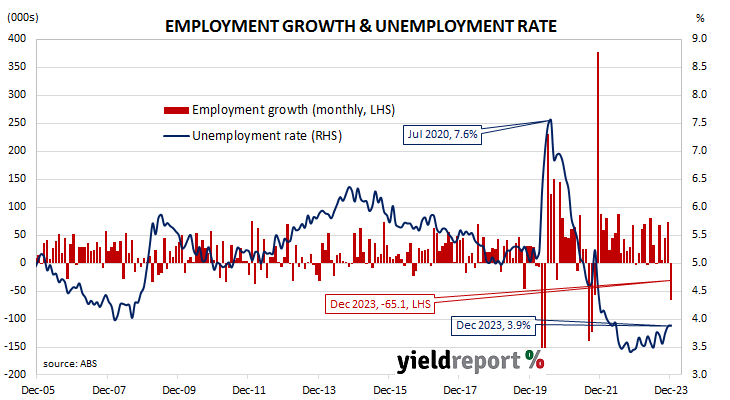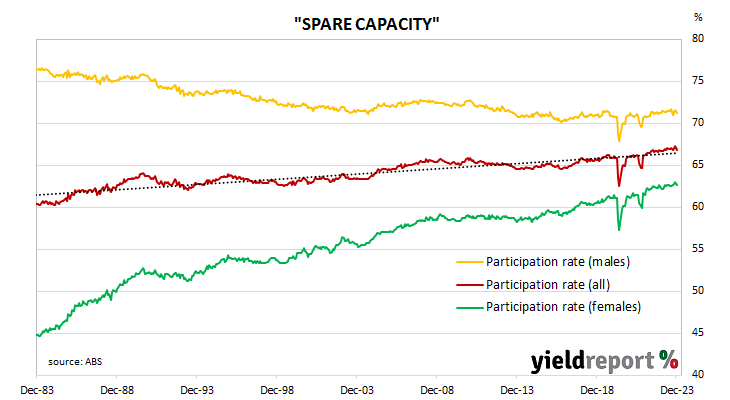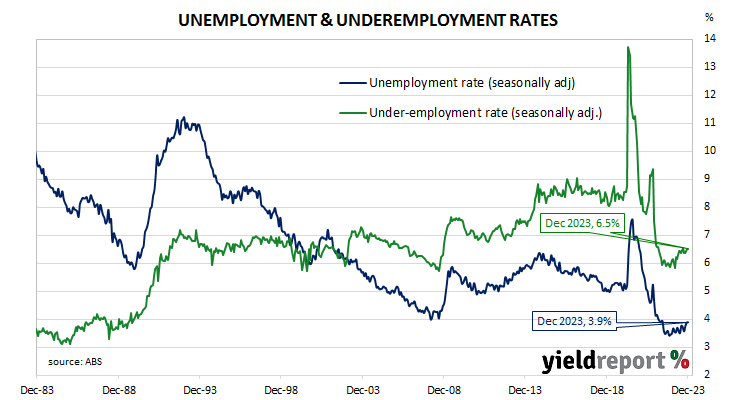Summary: Employment down 65,100 in December, contrasts with expected gain; ANZ: job growth still positive in Dec quarter but slower than Sep quarter; Westpac: broader picture is of labour market in transition; participation rate falls back from record high to 66.8%; jobless rate steady at 3.9%; more part-time jobs, fewer-time jobs; aggregate work hours down 0.5%; underemployment rate steady at 6.5%.
Australia’s period of falling unemployment came to an end in early 2019 when the jobless rate hit a low of 4.9%. It then averaged around 5.2% through to March 2020, bouncing around in a range from 5.1% to 5.3%. Leading indicators such as ANZ-Indeed’s Job Ads survey and NAB’s capacity utilisation estimate suggested the unemployment rate would rise in the June 2020 quarter and it did so, sharply. The jobless rate peaked in July 2020 but fell below 7% a month later and then trended lower through 2021 and 2022.
The latest Labour force figures have now been released and they indicate the number of people employed in Australia according to ABS definitions decreased by 65,100 in December. The result contrasted with the 15,000 increase which had been generally expected as well as November’s upwardly-revised gain of 72,600.
“Despite the decline in December, employment increased by 51,700 between September and December,” said ANZ senior economist Blair Chapman. “This was down from the 72,400 increase in the three months to September, consistent with a slowing labour market. Also consistent with that slowing, the participation rate declined in December, unwinding the increases seen in October and November, which prevented the unemployment rate from increasing in December.”
Domestic Treasury bond yields rose in manner broadly similar to movements of US Treasury yields overnight. By the close of business, the 3-year ACGB yield had gained 6bps to 3.82%, the 10-year yield had added 5bps to 4.28% while the 20-year yield finished 1bp higher at 4.56%.
In the cash futures market, expectations regarding rate cuts later this year softened. At the end of the day, contracts implied the cash rate would remain close to the current rate of 4.32% and average 4.325% through February, 4.315% in March and 4.305% in April. August contracts implied a 4.18% average cash rate while November contracts implied 4.025%, 29bps less than the current rate.
“The broader picture is of a labour market that is in transition, as softness begins to emerge after a period of historic tightness,” said Westpac economist Ryan Wells. “Volatility aside, individuals are participating in the labour market at record rates amidst the trifecta of household income pressures; elevated inflation, sharply higher interest rates and an increasing tax burden.”
The participation rate fell back from November’s revised figure of 67.3%, a record high, to 66.8% as the total available workforce decreased by 65,900 to 14.775 million while the number of unemployed persons declined by 800 to 573,600. As a result, the unemployment rate remained steady at 3.9% after rounding.
The aggregate number of hours worked across the Australian economy declined by 0.5% as 41,400 residents gained part-time positions and 106,600 residents lost full-time positions. On a 12-month basis and after revisions, aggregate hours worked increased by 1.2% as 276,200 more people held part-time positions and 104,700 more people held full-time positions than in December 2022.
More attention has been paid to the underemployment rate in recent years, which is the number of people in work but who wish to work more hours than they do currently. December’s underemployment rate remained unchanged from November’s figure of 6.5%, 0.7 percentage points above this cycle’s low.
The underutilisation rate, that is the sum of the underemployment rate and the unemployment rate, has a strong correlation with the annual growth rate of the ABS private sector wage index when advanced by two quarters. December’s underutilisation rate of 10.4% corresponds with an annual growth rate of about 4.0%.




